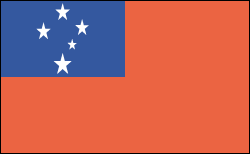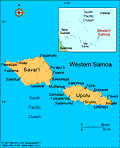Samoa | Facts & Information

- Samoa Profile
Facts & Figures
-
Independent State of Samoa
Head of State: Tuiatua Tupua Tamasese Efi (since 20 June 2007)
Prime Minister: Tuilaepa Sailele Malielegaoi (1998)
Land area: 1,100 sq mi (2,849 sq km); total area: 1,137 sq mi (2,944 sq km)
Population (2014 est.): 196,628 (growth rate: 0.59%); birth rate: 21.29/1000; infant mortality rate: 20.5/1000; life expectancy: 73.21; density per sq mi: 163.7
Capital and largest city (2011 est.): Apia, 37,000
Monetary unit: Tala
Languages: Samoan, English
Ethnicity/race: Samoan 92.6%, Euronesians 7% (persons of European and Polynesian blood), Europeans 0.4%
Religion: Congregationalist 31.8%, Roman Catholic 19.4%, Methodist 13.7%, Latter-Day Saints 15.2%, Assembly of God 8%, Seventh-Day Adventist 3.9%, other Christian 5.5%, other 0.7%, unspecified 0.1% (2011)
National Holiday: Flag Day, November 1
Literacy rate: 98.8% (2003 est.)
Economic summary: GDP/PPP $1.145 billion (2013 est.); per capita $6,200 (2013 est). Real growth rate: 0.1% (2013 est). Inflation: 2.7% (2013). Unemployment: n.a. Arable land: 2.82%. Agriculture: coconuts, bananas, taro, yams, coffee, cocoa. Labor force: 47,930 (2011 est.). Industries: food processing, building materials, auto parts. Natural resources: hardwood forests, fish, hydropower. Exports: $11.4 million (2011): fish, coconut oil and cream, copra, taro, automotive parts, garments, beer. Imports: $318.7 million (2011): machinery and equipment, industrial supplies, foodstuffs. Major trading partners: American Samoa, Australia, U.S., New Zealand, Fiji, Singapore, China (2012).
Communications: Telephones: main lines in use: 35,300 (2010); mobile cellular: 167,400 (2010). Radio broadcast stations: AM 2, FM 5, shortwave 0 (2004). Radios: 174,849 (1997). Television broadcast stations: 4 (2009). Televisions: 8,634 (1999). Internet Service Providers (ISPs): 18,013 (2012). Internet users: 9,000 (2009).
Transportation: Railways: 0 km. Highways: total: 2,337 km; paved: 332 km; unpaved: 2,005 km (2001 est.). Ports and harbors: Apia. Airports: 4 (2013).
International disputes: none.









